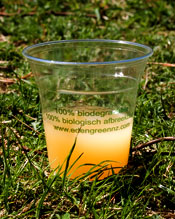Is Corn-Based Plastic (PLA) Really A Feasible Alternative To Plastic?
Dear EarthTalk: What are the environmental pros and cons of corn-based plastic as an alternative to conventional petroleum-based plastic?
—Laura McInnes, Glasgow, Scotland
Polylactic acid (PLA), a plastic substitute made from fermented plant starch (usually corn) is quickly becoming a popular alternative to traditional petroleum-based plastics. As more and more countries and states follow the lead of China, Ireland, South Africa, Uganda and San Francisco in banning plastic grocery bags responsible for so much so-called “white pollution” around the world, PLA is poised to play a big role as a viable, biodegradable replacement.
Proponents also tout the use of PLA—which is technically “carbon neutral” in that it comes from renewable, carbon-absorbing plants—as yet another way to reduce our emissions of greenhouse gases in a quickly warming world. PLA also will not emit toxic fumes when incinerated.
But critics say that PLA is far from a panacea for dealing with the world’s plastic waste problem. For one, although it does biodegrade, it does so very slowly. According to Elizabeth Royte, writing in Smithsonian, PLA may well break down into its constituent parts (carbon dioxide and water) within three months in a “controlled composting environment,” that is, an industrial composting facility heated to 140 degrees Fahrenheit and fed a steady diet of digestive microbes. But it will take far longer in a compost bin or in a landfill packed so tightly that no light and little oxygen are available to assist in the process. Indeed, analysts estimate that a PLA bottle could take anywhere from 100 to 1,000 years to decompose in a landfill.

Another issue with PLA is that, because it is of different origin than regular plastic, it must be kept separate when recycled, lest it contaminate the recycling stream. Being plant-based, PLA needs to head to a composing facility, not a recycling facility, per se, when it has out served its usefulness. And that points to another problem: There are presently only 113 industrial-grade composting facilities across the U.S.
Another downside of PLA is that it is typically made from genetically modified corn, at least in the U.S. The largest producer of PLA in the world is NatureWorks, a subsidiary of Cargill, which is the world’s largest provider of genetically modified corn seed. With increasing demand for corn to make ethanol fuel let alone PLA, it’s no wonder that Cargill and others have been tampering with genes to produce higher yields. But the future costs to the environment and human health of genetic modification are still largely unknown and could be very high.
While PLA has promise as an alternative to conventional plastic once the means of disposal are worked out, grocery shoppers could do well to by simply switch to reusable containers, from cloth bags, baskets and backpacks for grocery shopping (most chains now sell canvas bags for less than a dollar apiece) to safe, reusable (non-plastic) bottles for beverages. As for other types of PLA items—such as those plastic “clamshells” that hold cut fruit (and there is a whole host of industrial and medical products now made from PLA)—there is no reason to pass them by. But until the kinks are worked out on the disposal and reprocessing end, PLA may not be much better than the plain old plastic it’s designed to make obsolete.
CONTACTS: Smithsonian‘s “Corn Plastic to the Rescue”; NatureWorks

